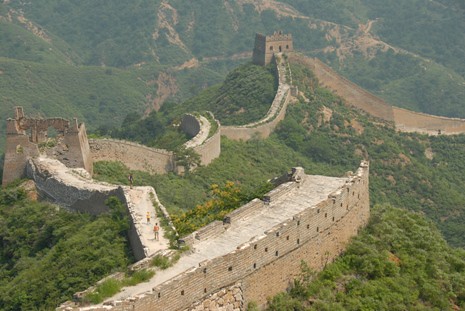Back in Beijing
Thirteen years ago I spent two years studying at the Beijing Language and Culture University. I haven’t been back since so I’m really excited to be here.
The city has changed so much but one thing which has mostly stayed the same is the food. We’ve been eating really well. I’ve been taking Pete to small restaurants hidden around corners from the more expensive places on the main streets. We’ve been eating jiaozi (boiled pork dumplings), baozi (steamed pork dumplings), spicy tofu, spinach with peanuts, amazing aubergine in a Beijing style, hot and sour soup, sweet and sour pork…
The food is about all that’s stayed the same though. We visited the university where I studied and I didn’t really recognise anything. It was all a bit emotional and weird. I coudn’t find any of the buildings where I used to live and study. It wouldn’t surprise me if they knocked them down for health and safety reasons actually. It’s all very professional looking now.
The city has changed beyond recognition. It’s looking shiny and spotless for the Olympics. The flowerbeds are flawless and the street cleaners are out in droves. There are new subway lines and hundreds of volunteer helpers (young students I think) all over the city, eager to help tourists in any way they possibly can. Everyone you see is in a good mood; really friendly and really excited about the Olympics coming to town.
The TV has Olympic fever too. There are entertainment programmes featuring all the Olympic songs (of which there seem to be many, but they all sound the same to me), news programmes about how well the preparations are going and sports programmes about all the soon-to-be stars of the games.
The souvenir shops are very interesting and packed full of shoppers. There are official shops all over town where you can buy miniature golden sculptures of the main arenas, teddy bears of the mascots, souvenir medallions, Olympic torches made out of metal left over from the Olympic stadiums (apparently) and many, many, many other mementos.
Me and Pete have also been doing some touristy things. We spent a sweltering day in the Forbidden City and did a ten kilometre walk along the Great Wall from Jinshanling to Simatai (also sweltering but with a bit of a breeze at least). We met up with Jerome and Julie again (we first met them in Mongolia) to do the walk which was lovely.
Of all the things we’ve done my favourite has been our visit to Factory 798 – a huge, former electronics factory which has been taken over by galleries exhibiting contemporary Chinese art. It’s an absolutely huge complex, not just one factory – I guess because Chinese factories also used to include housing, hospitals, schools etc. It’s a really exciting place, full of interesting and contemporary exhibitions, and it’s still developing and expanding.
Finally, just a note on what Pete says below. I am really enjoying speaking Chinese again after years of not speaking a word. I’m also pleasantly surprised how much of the language is coming back to me. I was well taught! However, my vocabulary really is limited and I’m a long way from dreaming in Chinese.
Superhumans
Ever since we left Leeds, I’m finding myself more and more impressed by people who can speak more than one language. I’m completely stupid with languages – sometimes I struggle even with English. So people who can communicate in other languages are like superhumans to me.
Here’s some examples:
Heiko and Martina – our German friends who can speak and write a remarkably clear and precise English – superhumans. Julie and Jerome – who although they speak French as their first language will sometimes dream in English or German – superhumans. Susan Giblin – who can joke around with taxi drivers and other locals in Beijing – superhuman!
Susan allows her modesty to discredit herself. “Oh my vocabulary is terrible” she says. “I don’t understand everything they’re saying” she says. “I’m not fluent” she says. “Yeah, yeah, yeah” is what I say to all that. She’s one of those superhuman people I keep getting amazed by. She can actually make some sense out of all those strange sounds I hear coming from peoples’ mouths here. And she can make some of them back too. It’s all the more amazing because it’s Susan – she doesn’t do that so much at home you know.
I just mostly watch while Susan does the talking. It’s great. The people Susan talks to seem to really appreciate her efforts. I’ve seen the faint traces of a smile on a very stern looking train ticket seller. I’ve seen the big grins on the taxi drivers while they’re chatting and joking with her. I’ve heard the “you speak very good Chinese” comments (when they’ve been in English that is). And best of all, I’ve been in the restaurants when she’s ordering food.
One restaurant has been particularly fine. We’ve been there twice now – it’s more like a family run cafe I guess. The first time we went in there, Susan walked in and asked if they had Jiaozi (boiled dumplings that she used to really like when she lived here). The waitress answered in the affirmative and this seemed to be echoed enthusiastically by the locals who were sitting at a table. There were some unintelligible talking, a few laughs and smiles here and there and the next thing you know I’m eating some really delicious food. Fantastic. This is the good life.
Note: Unfortunately our photos from the Great Wall were stolen along with our camera. Big thanks to Julie and Jerome for sending us a few to include on our blog.
